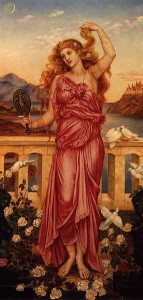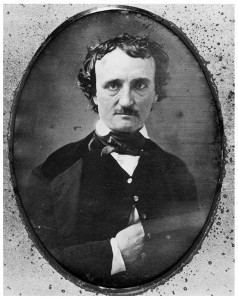
Helen, thy beauty is to me
Like those Nicéan barks of yore,
That gently, o’er a perfumed sea,
The weary, way-worn wanderer bore
To his own native shore.
On desperate seas long wont to roam,
Thy hyacinth hair, thy classic face,
Thy Naiad airs have brought me home
To the glory that was Greece,
And the grandeur that was Rome.
Lo! in yon brilliant window-niche
How statue-like I see thee stand,
The agate lamp within thy hand!
Ah, Psyche, from the regions which
Are Holy-Land!

Edgar Allen Poe is one of the most well known American writers to emerge during the 19th century. His professional writing career spanned all areas of literature, including poetry and short story. A poet of the Romantic Movement, Poe is credited with the invention of modern detective fiction and even acknowledged as a main contributor to the science fiction genre. Poe’s most famous works include his poem “The Raven,” his short story “The Fall of the House of Usher,” and his short story “the Murders in the Rue Morgue.”
First published in 1831, his poem “To Helen” alludes to the infamously beautiful Helen of Troy. The poem explores the idea of a woman’s beauty, both in terms of body and soul. Interestingly enough, this poem depicts one of Poe’s mentors, Mrs. Jane Stanard of Richmond, VA. The mother to one of his childhood friends, Mrs. Stanard is said to have been one of the first to encourage and foster Poe’s interest in poetry.
The beginning of the poem depicts Helen as the symbol of physical beauty. In Greek mythology, Helen of Troy is the most beautiful woman that ever lived and is the reason for the ten year long Trojan War. Poe compares Helen’s appearance to the ships, the “Nicéan barks of yore,” that brought the victorious soldiers home to Greece and Rome. Helen’s association with boat imagery relays the idea that she is a vessel that moves the most powerful classical civilizations. By urging Poe to write poetry, Mrs. Stanard served as an inspiration for Poe’s writing. His writing style often emulates the classical tradition of Greece and Rome. Just as Helen serves as the “Nicéan barks of yore” for travelers, Mrs. Stanard is the vessel for young Poe.
The second half of the poem explores a woman’s soulful beauty with the allusion to Psyche, the goddess of the soul. In Greek mythology, Psyche discovers the true identity of her husband, Cupid, when she holds a candle above him while he sleeps. In the poem, Poe depicts Psyche, “How statue-like I see thee stand, / The agate lamp within thy hand!” Poe’s lines serve as a direct connection to the story between Psyche and Cupid. By referencing the goddess of the soul, Poe relays the idea that Helen possesses both outer and inner beauty.
Poe’s poem “To Helen” is a glorification of one of his childhood mentors who inspired him immensely. Poe creates Helen, or Mrs. Stanard, to possess both outer and inner beauty that captures him as a young boy and perhaps, even as an adult. With the mention of “Naiad airs,” Poe alludes to the mythological nymphs of the water, the Naiads. The Naiads’ restful and peaceful nature seem to ring true to Helen’s persona, which brings him back to his picturesque childhood which he refers to as the “Holy-Land.” Poe’s placement of Mrs. Stanard, or Helen, on a pedestal as one of his beloved childhood mentors speaks to his lifelong admiration of her. She still exists in Poe’s mind as a woman that captures all types of beauty and who he thinks of as his Helen of Troy.
